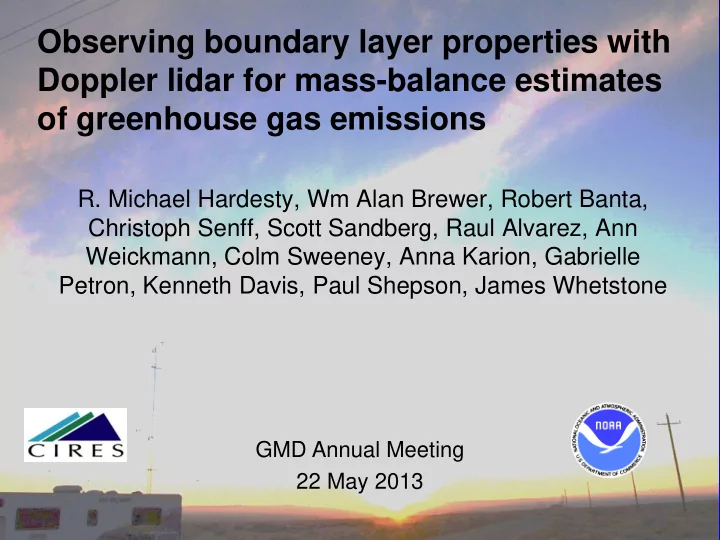

Observing boundary layer properties with Doppler lidar for mass-balance estimates of greenhouse gas emissions R. Michael Hardesty, Wm Alan Brewer, Robert Banta, Christoph Senff, Scott Sandberg, Raul Alvarez, Ann Weickmann, Colm Sweeney, Anna Karion, Gabrielle Petron, Kenneth Davis, Paul Shepson, James Whetstone GMD Annual Meeting 22 May 2013
Mass-balance estimates of emissions: what boundary layer properties do we need to know? Daily flight planning •Wind speed/direction •Mixing layer depth Wind Wind Enhanced VOCs, CH 4 Computing emissions • Time history of the wind speed and direction • Evolution of the mixing layer • Presence of a residual layer
Mass-balance estimates and evolution of the boundary layer Nocturnal LLJ • Mixing layer depth is well-defined during morning and early afternoon as boundary layer grows and heating is maintained • During middle to late afternoon heating diminishes and depth becomes more difficult as residual layers form • Probably best to fly around mid-day
Doppler lidar sensing of mixing layer height Vertical Velocity Variance (Hogan et al, JAS) Horizontal wind profile Aerosol structure
NOAA High Resolution Doppler Lidar NOAA High Resolution Doppler HRDL Wavelength : 2 microns (invisible/eyesafe) Lidar Resolution : 30m (along beam) / 1-2 Hz Wavelength : 2 microns Scanning : Full hemispheric HRDL (invisible/eyesafe) Max Range : 4-5 km typical Resolution : 30m (along beam) / 2 Hz Surface, air, and shipboard deployments Scanning : Full Hemispheric Runs autonomously and continuously Max Range : 4-5km typ
Scanning for boundary layer 20 minute repeating scan pattern PPI characterization Shallow RHI 0 Vertical • Scan sequence repeats every 20 minutes • Combination of scans and staring 10 -vertical stare (10 minutes) -conical scans: 2°,4°, 25°, 45° (7 minutes) minutes -vertical scans: 2 orthogonal (3 minutes) 20 min
Wind profiles every 20 minutes - From within a few meters of the ground through the top of the BL 5-15 m vertical resolution
Vertical velocities : form statistics from repeating 10 minute collection periods 3000 3000 Ht (m) Ht (m) 1500 1500 0 0 24:00 0:00 12:00 18:00 12:00 06:00 Time (UTC) Time (UTC)
Boundary Layer Development
Wind Speed Wind Direction Vertical velocity variance Vertical velocity skewness Aerosol
Residual layers: Denver-Julesburg
Lidar characterization of the boundary layer for INFLUX
Installation at Ivy Tech Community College NE of Indianapolis
Current Status • Doppler lidars have been deployed in 5 experiments to characterize boundary layer depth and dynamics for greenhouse gas emissions measurement – Unitah Basin 2012 – Denver-Julesburg 2012 – Uintah Basin 2013 – Barnett Shale 2013 – INFLUX 2012 • A commercial mini Doppler lidar is installed at Indianapolis for INFLUX and is operating • Some receiver problems at low signal level are being investigated • We’re currently pursuing algorithms for automated estimates of mixing layer depth
Backups
Acknowledgement Coauthors: R. M. Hardesty, W. A. Brewer, R. M. Banta, A. O. Langford, R. J. Alvarez II, S. P. Sandberg, A. M. Weickmann, R. D. Marchbanks, A. Karion, C. Sweeney, G. Petron NOAA Twin Otter flight crews & NOAA Aircraft Operations Center Steven Conley, UC Davis, Mooney AC Pilot NOAA Health of the Atmosphere Program Uintah Impact Mitigation Special Service District, Western Energy Alliance, BLM, EPA, NSF, State of Utah
Atmospheric Boundary Layer Diurnal Variation 2000 Inversion 1500 Height (meters) Convective Mixed Layer 1000 Residual Layer Residual Layer 500 Stable (nocturnal) Layer Stable (nocturnal) Layer 0 Sunrise Sunrise Noon Sunset Adapted from Introduction to Boundary Layer Meteorology -R.B. Stull, 1988
Stacked PPIs for wind profiling 1 m vert res 5 m vert res 15 m vert res
Methane Flux downwind of Oil & Gas Operations (Uintah Basin Winter Ozone Study 2012) Methane Wind profiles/Mixing height Airborne in situ observations Ground-based High Resolution Doppler Lidar (HRDL) Mooney TLS-20 Scientific Aviation, Inc. Flasks NO 2 (50+ species) O 3 CH 4 , CO 2 , H 2 O
Uintah Basin, Utah Colorado Utah Horse Pool oil wells Bonanza Creek Power Plant Duschesne Co. Uintah Co. gas wells ~60 km (Google Earth)
3 Feb 2012: Aircraft CH 4 measurements Vertical Horse Pool profiles (HRDL lidar) Back trajectory
3 Feb 2012: Aircraft CH 4 measurements downwind CH 4 (ppb) upwind Flight track distance perpendicular to wind (km) ( x cos θ )
3 Feb 2012: HRDL lidar observations Wind Speed and Direction Altitude , m AGL Wind speed , m/s Mixing height Altitude , m AGL
Uintah Basin: Methane emissions estimates Δ X CH4 , Date Wind PBL depth , CH 4 mass flux , Relative ppbv speed , m/s m AGL metric tons/h Uncertainty 3 Feb 56 5.2 1700 56±15 28% 2012 7 Feb 245 1.2 700 30±19 62% 2012
Horizontal Velocities : Spatial variability Horizontal Velocity (ms -1 ) 1.5 3 Height (km) Height (km) 0 0 -3 0 1 2 3 4 5 6 1.5 3 0 0 -3 0 1 2 3 4 5 6 Range (km) One minute to form horizontal variance profiles, cover from the ground though cloud base. Samples scales of 30m – 6km.
Halo – HRDL comparisons
Calculating wind profile from PPI scans Wind Direction Wind Speed
Recommend
More recommend